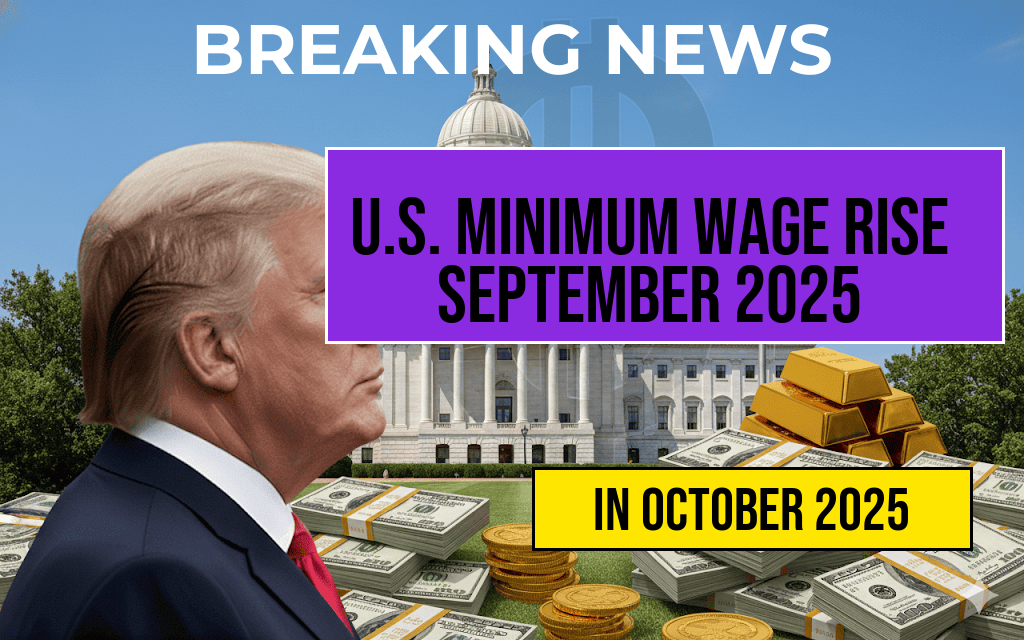The United States will see an increase in the federal minimum wage starting September 30, 2025, marking a significant shift in the nation’s labor standards. This adjustment reflects ongoing efforts to address wage stagnation and inflation pressures, impacting millions of workers nationwide. The new rates, which vary by state and locality, aim to ensure that minimum wages keep pace with economic changes while considering regional cost-of-living differences. As states prepare to implement these changes, employers and employees alike are navigating the implications for payroll, budgeting, and employment policies. This article provides a comprehensive overview of the upcoming wage increase, including the full list of new hourly rates across different jurisdictions and insights into how these changes may influence the broader economic landscape.
Understanding the Federal Minimum Wage Adjustment
The federal minimum wage, originally established in 1938 under the Fair Labor Standards Act (FLSA), has undergone numerous adjustments over the decades. The last federal increase occurred in 2009, setting the minimum at $7.25 per hour. However, many states and cities have implemented their own higher minimum wages, often driven by local economic conditions and living costs.
The upcoming change on September 30, 2025, is part of a broader movement to update wage standards in response to inflation and economic growth. While the federal government sets a baseline, individual states and municipalities may set higher rates, which often take precedence for local workers. This layered approach aims to balance national economic stability with regional affordability.
Key Factors Influencing the Wage Increase
The decision to increase minimum wages is influenced by several economic indicators, including inflation rates, median income levels, and employment trends. The Consumer Price Index (CPI) and other inflation measurements have shown a steady rise over the past few years, prompting policymakers to adjust wage standards accordingly.
Additionally, labor advocates argue that higher wages are essential for reducing income inequality and improving worker quality of life. Employers, meanwhile, are preparing for the financial impact of these increases, with some exploring automation and efficiency measures to offset higher labor costs.
Full List of New Hourly Rates by State and Localities
While the federal minimum wage will increase to $10.50 per hour nationwide, numerous states and cities will implement higher rates based on local legislation. Below is a comprehensive table highlighting the new hourly wages effective September 30, 2025:
| Region | Previous Rate | New Rate | Notes |
|---|---|---|---|
| California | $15.50 | $16.50 | Increases phased in over the year |
| New York City | $15.00 | $17.00 | For large employers; smaller businesses may have different schedules |
| Texas | $7.25 | $10.50 | Follows federal minimum |
| Florida | $11.00 | $13.00 | State law mandates regular updates |
| Illinois | $13.00 | $14.50 | Includes phased increases through 2026 |
| Washington | $15.74 | $16.74 | Minimum wage adjusted annually based on inflation |
| Massachusetts | $14.25 | $15.25 | Incremental increases scheduled through 2026 |
| Alaska | $10.85 | $11.85 | Increased to reflect regional economic conditions |
Note that some localities have set rates that surpass state or federal minimums, reflecting regional economic priorities and cost-of-living considerations. For example, Seattle and San Francisco have minimum wages significantly higher than state mandates, often approaching or exceeding $17 per hour.
Implications for Employers and Workers
Employers across various sectors will need to adjust their payroll systems to comply with the new wage standards. Small businesses, in particular, may face challenges balancing increased labor costs with competitive pricing and profit margins. Many are already exploring automation or restructuring to mitigate financial pressures.
For workers, the wage increase promises improved income levels, which can lead to better access to housing, healthcare, and other essentials. However, some critics argue that higher wages could lead to increased prices for goods and services or potential job reductions in certain industries.
Legal and Policy Context
The wage increase aligns with ongoing federal and state efforts to establish living wages that reflect current economic realities. While the federal baseline remains at $7.25 per hour, more aggressive regional standards have gained traction, with some states enacting laws to surpass federal minimums annually.
For more information on the history and future of minimum wage policies, visit Wikipedia’s Minimum Wage in the United States.
Looking Ahead
As the September 30, 2025, date approaches, stakeholders are closely monitoring the economic effects of the wage adjustments. Policymakers, economists, and labor groups will continue evaluating whether these increases meet their intended goals of reducing poverty and fostering sustainable economic growth.
Workers and employers alike should prepare for the transition, ensuring compliance with new regulations and understanding how the changes will impact their financial planning. The adjustments mark a noteworthy step in the evolving landscape of American labor standards, emphasizing the nation’s ongoing dialogue between economic growth and worker well-being.
Frequently Asked Questions
What is the effective date of the new U.S. minimum wage increase?
The new U.S. minimum wage will take effect on September 30, 2025.
How will the minimum wage vary across different states and regions?
The full list of new hourly rates provides specific minimum wage figures for each state and region, reflecting regional adjustments and updates.
Which employers are affected by the new minimum wage rates?
The updated minimum wage rates apply to covered employers across various industries, including retail, hospitality, and service sectors.
Are there any exceptions or special cases for the new minimum wage?
Yes, some exceptions may apply, such as youth, tipped employees, or specific exempt industries, according to federal and state regulations.
Where can I find the complete list of the new hourly rates?
The full list of new hourly rates is included in the article, providing detailed information for all applicable states and regions.

Leave a Reply